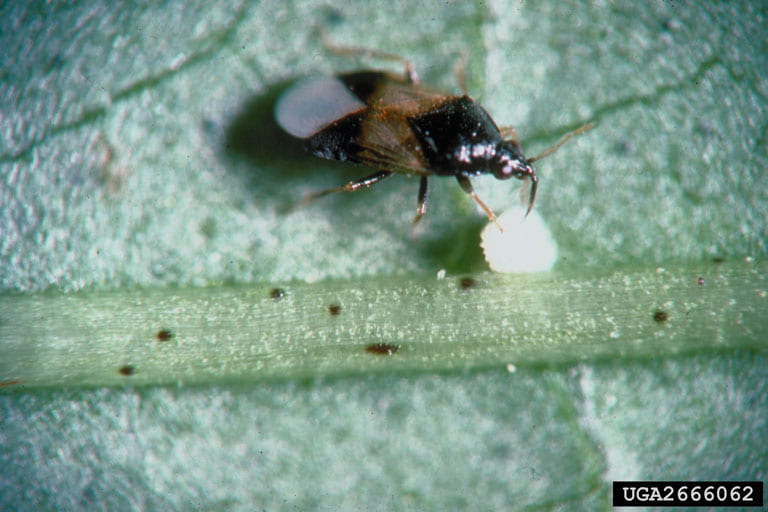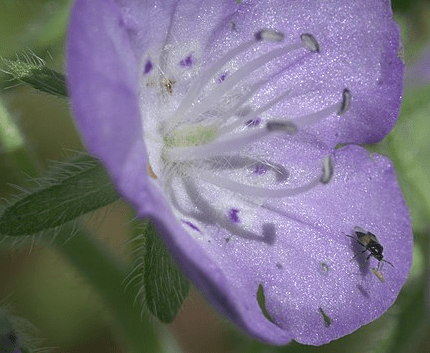The current hot, dry weather can be conducive to outbreaks of thrips. Thrips are very small, slender, elongate, cigar-shaped insects, about 1 mm (1/25 inch) long. They differ from other insects by having thin strap-like wings that are fringed with hairs. The wings are usually folded lengthwise over the back when they are resting or feeding, as shown in the image below. They have asymmetrical mouthparts that have a well-developed left mandible and an underdeveloped right mandible. They feed by piercing plant cells by the mandible then sucking sap that oozes out of the punctured cells.

Smaller, tan thrips on left is the onion thrips (Thrips tabaci). Larger yellowish thrips on the right is the western flower thrips (Frankliniella occidentalis).
Photo by Alton N. Sparks, Jr., University of Georgia, Bugwood.org
Thrips generally have flowers as their preferred plant part but they also feed on leaves and fruits. They are found in flowers of many ornamental plants but also on various vegetables and fruit crops, including tomatoes, peppers, and cucumbers. Thrips are often overlooked due to their small size and their tendency to hide in protected places. When present at low density, thrips are usually not harmful to crops, but when they reach higher density, they can feed on the surface of fruits and cause injury.
The thrips species that infests many outdoor crops is Frankliniella tritici, which has the official common name of ‘flower thrips’, but which is widely known as the eastern flower thrips. The thrips species that is most common in greenhouses is the western flower thrips, Frankliniella occidentalis, which is generally much more difficult to control than other thrips because it is not highly susceptible to most insecticides. A third common species is the onion thrips (Thrips tabaci), which is a serious pest of dry bulb onions and green onions as well as cabbage.
Natural enemies of thrips are Orius flower bugs, which are very small predatory true bugs that prey on thrips as adults and nymphs. Orius insidiosus is a common species in Ohio that is frequently found on the moist fresh silks of sweet corn and on flowers of Queen Anne’s lace. There are also several species of predatory mites that prey on thrips.

Insidious flower bug (Orius insidiosus) feeding on an insect egg.
Photo by John Ruberson, Kansas State University, Bugwood.org

Orius bug feeding on a thrips.
Photo by Robert Webster / xpda.com / CC-BY-SA-4.0 via Wikimedia Commons.
Thrips can be monitored by shaking flowers over a paper or into a cup or zip-top sandwich bag, which should then be examined for the dislodged thrips running around on the surface. Action thresholds have not been developed for most crops, but on strawberry we use a threshold of 2 thrips per flower.
In the past, pyrethroid insecticides provided control of thrips, but there are widespread observations that pyrethroids are no longer very effective for thrips control at most locations. Newer insecticides used to control thrips on conventional crops include Radiant, Assail, and several others, as shown in Table 1 below. Products for thrips control on organic crops include Entrust and various others as shown in Table 2 below.
If a biological control approach is preferred, natural enemies are available for purchase from commercial insectaries for thrips control: Orius (predatory flower bugs), and two species of predatory mites: Amblyseius cucumeris and Ambylseius swirskii. Beneficial nematodes such as Steinernema feltiae are another option. Microbial options include sprays of the beneficial fungus Beauveria bassiana, which is found in several commercial products. Biocontrol is not feasible to begin once the thrips population is large but can be planned in advance at locations that have a consistent problem with thrips.
-Celeste Welty, Extension Entomologist

